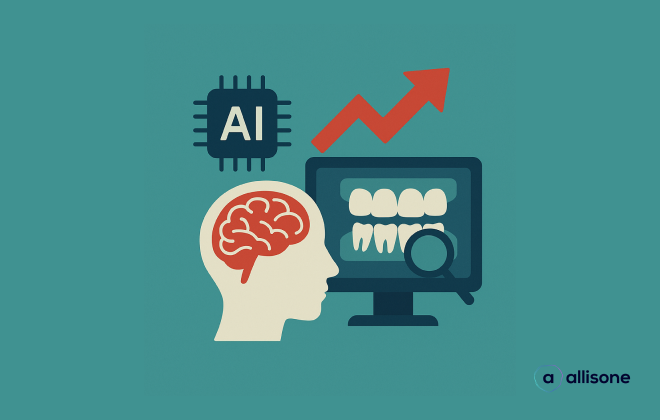
It is generally considered that the "birth" of artificial intelligence dates back to 1956. At the Dartmouth Conference, John McCarthy, an eminent American mathematician, convinced a small audience to accept AI as a science. Since then, this new discipline has experienced considerable growth and evolution: video games, GPS, smartphone applications, social network news feeds, targeted advertising, streaming platforms or connected objects have gradually imposed themselves in our lives and now influence the way we think and act. What about in the field of dentistry? What developments has AI seen in this sector, and what place does it occupy within the profession? We tell you everything.
Some historical landmarks
One of the first applications of AI to dentistry dates back to 1995. A British dentist published a study on the use of an AI to screen for oral cancers or pre-cancers. He revealed that the screening capabilities of his AI approached those of the dentists participating in the study.
Fifteen years later, in 2009, Korean scientists succeeded in establishing a predictive model of dental pain, depending on many factors such as the frequency and schedule of tooth brushing, the use of dental floss, the condition of the toothbrush, the diet... In the same year, with the development of "data mining" - understanding the exploration by algorithms capable of establishing correlations between different databases - Finnish scientists succeeded in establishing the longevity of different dental restoration materials within three age groups by analyzing the data of more than 1600 patients and nearly 20,000 procedures.
The next decade was the advent of AI. It has developed and spread, finding applications in all areas of dentistry: diagnosis, patient management, radiology, prosthetics...
AI soon to be a must in dental practice?
Twenty-five years after the first predictive and decision support models in dentistry appeared, AI has improved a lot technically. It has even become a recognized method for identifying a patient at risk of developing oral cancer. Regularly, new technologies based on AI are appearing. Their use remains limited for the moment - mainly because of the cost of investment and maintenance - but could well be brought to generalize rapidly. Here are some examples of promising AI applications in dentistry:
- Patient management: "Intelligent virtual assistants" can help the dentist organize patient records by performing tasks such as booking appointments and providing information. They then provide analytical assistance to the practitioner in establishing the diagnosis and treatment plan by highlighting certain elements in the patient's file.
- Prosthetics: The use of AI for the design and positioning of prostheses is a great advance. CAD/CAM (Computer Aided Design and Manufacturing) is a set of coordinated technologies that allows the digital acquisition of clinical data (by intra-oral camera or scanner), the modeling of custom prostheses and implants, and then their fabrication (by 3D printing or milling). It has made restorations more precise and is now used to manufacture crowns, bridges, inlays or onlays. CAD/CAM can also be used to create removable or maxillofacial prostheses and implant abutments and bars.
- Orthodontics: AI is used throughout the orthodontic treatment path. Using 3D intra-oral cameras, practitioners can assess anomalies, and help build custom aligners. With a predictive tooth movement model, AI then plans pressures and directions to apply to each tooth, reducing the number of adjustments and treatment time.
- Radiology: Coupled with imaging systems such as MRI or cone beam (CBCT), AI can identify minute structural deviations invisible to the human eye. Professionals in the field use it to diagnose proximal caries or to locate abnormal lymph nodes.
AI innovation: US and China lead, Europe lags behind
In the AI race, three competitors stand out: the United States, China and Europe. The first are undoubtedly the pioneers of AI, as it was developed in the United States in the mid-1950s.
Today, the country still largely dominates the sector thanks to large-scale private companies and massive investments in research and development. We can mention Google, the initiator of Google Brain (a deep-learning research project used in the voice recognition systems of Android) and owner of Deepmind (developer of Alphago, a program known for having beaten the world champion of the Go game).
Other key American companies in the AI field are Apple and Amazon, which have developed virtual assistants based on voice recognition. Overall, the country is very attractive and many foreign researchers come here. Silicon Valley alone, located in California, is home to more than 7,000 companies and start-ups dedicated to new technologies, alongside major universities.
China is the most serious competitor to the United States. And for good reason: the country has ambitions to become the world leader in AI by 2030. It has already become the world's largest investor in the sector in 2017. Through strategic plans, the Chinese government is focusing on education and training and trying to limit the departure of students and researchers abroad.
By blocking access to the services of American giants, the country encourages the development of solutions by local companies such as Baidu (a kind of Chinese Google) Alibaba (developer of an AI capable of outperforming humans in a reading test), or Tencent (which conducts fundamental research on security and transportation).
China is also particularly advanced in AI techniques dedicated to facial recognition.
The European Union, even if it remains in the top three, seems to lag behind its main competitors. The reason: a lack of incentives that causes a brain drain towards better working conditions and remuneration.
While in 2019 in the United States AI startups received $14 billion, companies based in China received $6 billion and those in the EU ... only 3.2! Yann le Cun, a Frenchman considered one of the founding fathers of deep-learning, for example, joined the American company Facebook in 2013.
Yet France stands out among EU countries and is putting the means to catch up: the country has just entered phase II of its national AI strategy by announcing a new €2 billion envelope over 5 years. The number of French start-ups dedicated to AI is steadily increasing (+11% this year, or 502 entities). And the Paris Saclay science and technology cluster, a sort of French Silicon Valley, is emerging as a world-class innovation hub.
The United Kingdom leads the way in innovation within the Union, followed closely by France. But with the Brexit, EU funding allocated to AI is likely to fall. Added to this is "hard" data protection regulation dictated by the RGPD, whose fines are deterring some companies from investing in AI research. Nevertheless, this ethical, protective and regulatory vision dear to Europe has all the reasons to exist in the case of AI, because it puts the human being in the foreground by preventing the drifts that can arise from less strict frameworks. It could even be valued, provided that the international community adheres to it...
Articles en lien
Lorem ipsum dolor sit amet, consectetur adipiscing elit.

Comment l’intelligence artificielle optimise le diagnostic médical et la compréhension patients

L'avenir des cabinets dentaires : intelligence artificielle et gestion connectée au service des praticiens






